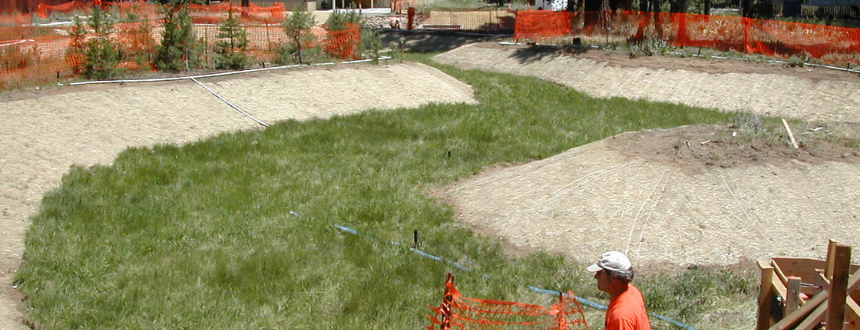
Biostrips and bioswales are vegetated sections of land over which stormwater moves as sheet flow (i.e., flow over plane surface where water spreads out at uniform depth). Bioswales are vegetated channels that receive and direct the concentrated flow of stormwater. These systems provide biofiltration and should use grasses, forbs, and ground cover for vegetation.
Biostrips and bioswales use plants to capture sediment, reduce the velocity and volume of stormwater runoff, and biologically degrade pollutants. Compost in biostrips and bioswales improves soil properties, reducing the erosive power of stormwater and improving plant growth and health.
Where to Use Treatment
Use biofiltration systems to manage stormwater runoff from roadways, parking lots, and impervious urban areas. Use biofiltration systems as the first stage of a group of treatments.
Benefits of Biofiltration Systems
- Aesthetically pleasing
- Reduces stormwater runoff velocity
- Traps sediment
- Reduces runoff of heavy metals
- Very cost effective per volume of runoff treated
- Adsorbs contaminants, including oil and gasoline
Limitations
- Do not use vegetated biostrips and bioswales in arid regions as irrigation is necessary for plant establishment and rainfall and runoff may be insufficient for plant health. Consider using non-vegetated swales with gravel mulch or similar inert materials.
- Must have a minimum vegetative cover of 70% within first full growing season.
- Evaluate nearby fill slopes to determine if erosion control measures are required to prevent excess sedimentation entering strips and swales.
- Design vegetation strips as flat as possible. Keep biofiltration strip slopes at 4:1 or flatter for new construction, widening, or when otherwise modified.
Maintenance
- Mow, irrigate, and prune plants as required for plant health and aesthetics.
- Remove sediments, trash, and plant trimmings as necessary and dispose of properly in accordance with governmental requirements.
- Regrade to reshape if necessary.
Resources
- For Caltrans specifications and additional guidance on biofiltration strips and swales, go to Biofiltration.
- California Stormwater BMP Handbook on Vegetated Swales: Vegetated swales
- Guidance for using bioswales and vegetated buffers for reducing, minimizing, or eliminating pollutant discharges to surface waters: Oregon DEQ Biofilters Guidance for Stormwater Discharge Pollution Removal
Research
Lim, H.S. et al (2015): Comparison of filter media materials for heavy metal removal from urban stormwater runoff using biofiltration systems. Journal of Environmental Management, 147: 24-33. Comparison of filter media materials
For Caltrans research, go to Caltrans Research.
For more information contact: Organic Materials, organics@calrecycle.ca.gov

